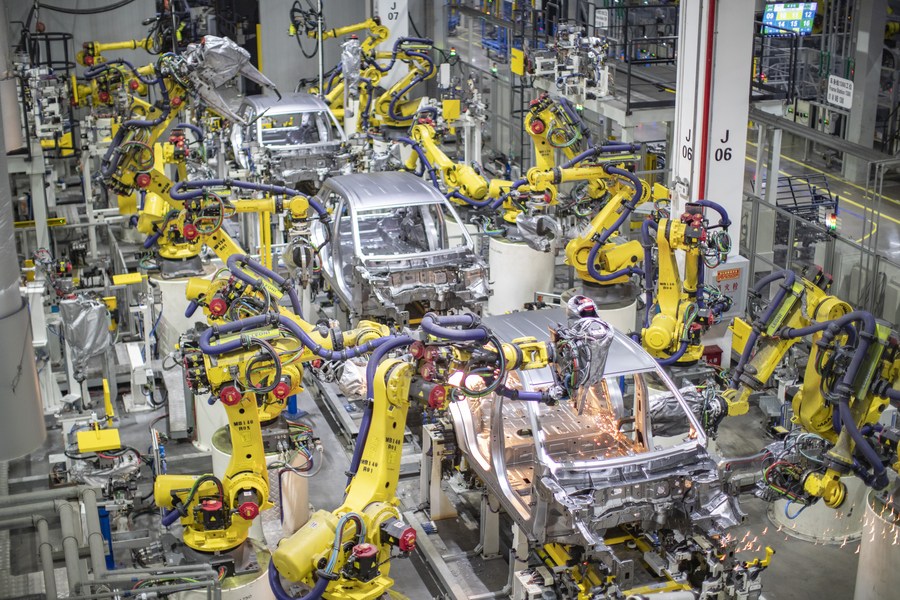Made-in-China new energy buses race towards overseas markets

Intelligent robots weld bodies of cars at a new energy vehicle company in Chongqing, southwest China, April 2, 2021. (Xinhua/Huang Wei)
XIAMEN, March 6 (Xinhua) -- In the workshop of Xiamen Golden Dragon Bus Co., Ltd., a leading bus maker in China, workers have been busy at the final assembly line, installing windshields and debugging the systems on new energy buses.
The fleet of 94 buses will soon be shipped from Xiamen Port in east China's Fujian Province, to Norway and Denmark.
"Our main focus this year is to further tap the European market," said An Min, who is in charge of Golden Dragon's overseas sales.
Entering the European market is no easy task for Chinese auto makers, which An described as "teaching fish to swim." On the one hand, the European market has set a demanding criterion for manufacturing accuracy. On the other hand, the market has long been occupied by local brands such as Mercedes-Benz, MAN Truck&Bus and Scania.
But Golden Dragon has made this possible with sedulous research on technology and tailor-made products for the European market.
Since 2002, the company has set up an R&D team focused on new energy buses in China. Together with many famous seats of learning such as Peking University, Xiamen University and Beijing Institute of Technology, the company has successfully launched a series of pure, hybrid electric vehicles and hydrogen fuel cell powered buses.
"We have mastered the core technologies of battery, electric control and motor, as well as automatic driving, which helped us accumulate an edge in the R&D, production and manufacturing of new energy buses," An said.
In 2020, Golden Dragon exported its first batch of new energy buses to the European market, consisting of 20 units that were shipped to Norway. These buses featured customized designs in materials and technology.
Most of the China-made buses exported to Nordic countries used the same materials to manufacture the body as those used in the domestic market, but Golden Dragon replaced the conventional high-strength steel with stainless steel.
"We made the change after lots of research, during which we found that the snowmelt agent widely used during the lingering snow and ice season in the Nordic countries can easily corrode high-strength steels," said An, adding they frequently invite customers to offer feedback and make corresponding adjustments in subsequent production.
"We have formed a virtuous circle, a kind of joint development between us and the customers. Our products are therefore well recognized and the quality keeps improving," noted An.
In 2022, the company's export value of new energy buses to the European market reached 42 million euros (about 44.7 million U.S. dollars), twice as much as that in 2020.
"In Norway and Denmark, We have more than 150 units running so far. For this year, we planned to import about 140 units," said Torbjorn Lundebrekke, technical manager of Eurobus Nordic, one of the distributors of Golden Dragon in Europe.
"We are looking at product development and new models and new possibilities in the market for sure. We will also strengthen the existing models and increase both the quality and furnishing level to meet the customers' high requirements," Lundebrekke added.
Other than the European market, Golden Dragon has also expanded its presence in Asia and Africa. According to An, the company received an order for 1,850 new energy buses from Thailand last year, the biggest single order it has ever received in a single market.
In the past decade or so, Golden Dragon's new energy buses have been running in countries and regions including Israel, the Netherlands, Norway, Denmark, Finland and Pakistan, making an important contribution to the development of the global green economy.
Similar to Golden Dragon, many Chinese auto makers are accelerating their pace in exploring more overseas markets. Data from the China Association of Automobile Manufacturers shows that exports of new energy vehicles (NEVs) increased 1.2 times year on year to 679,000 units in 2022.
Wang Jianling, an associate professor at Xiamen University, said global demand for NEVs remains strong, which leaves a broad development potential for China's NEV manufacturers.
In the past decade, China has formulated a package of supportive policies to boost the development of the NEV industry. And auto companies have actively responded to the call and the overall strength of the industry has continued to grow, noted Wang.
"Now Chinese companies can meet the diversified global market demand not only in terms of the design and quality, but also in the capacity of R&D and production," said Wang, adding more efforts are needed to further raise the core competitiveness and brand image of the domestic brands.


